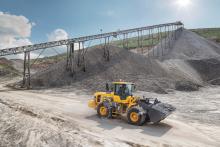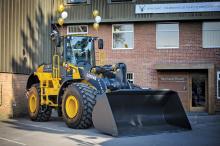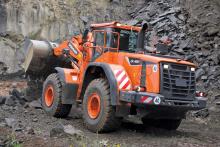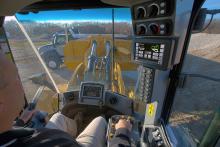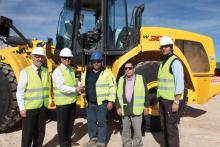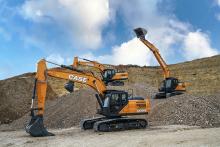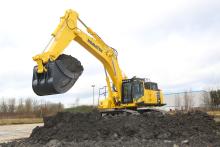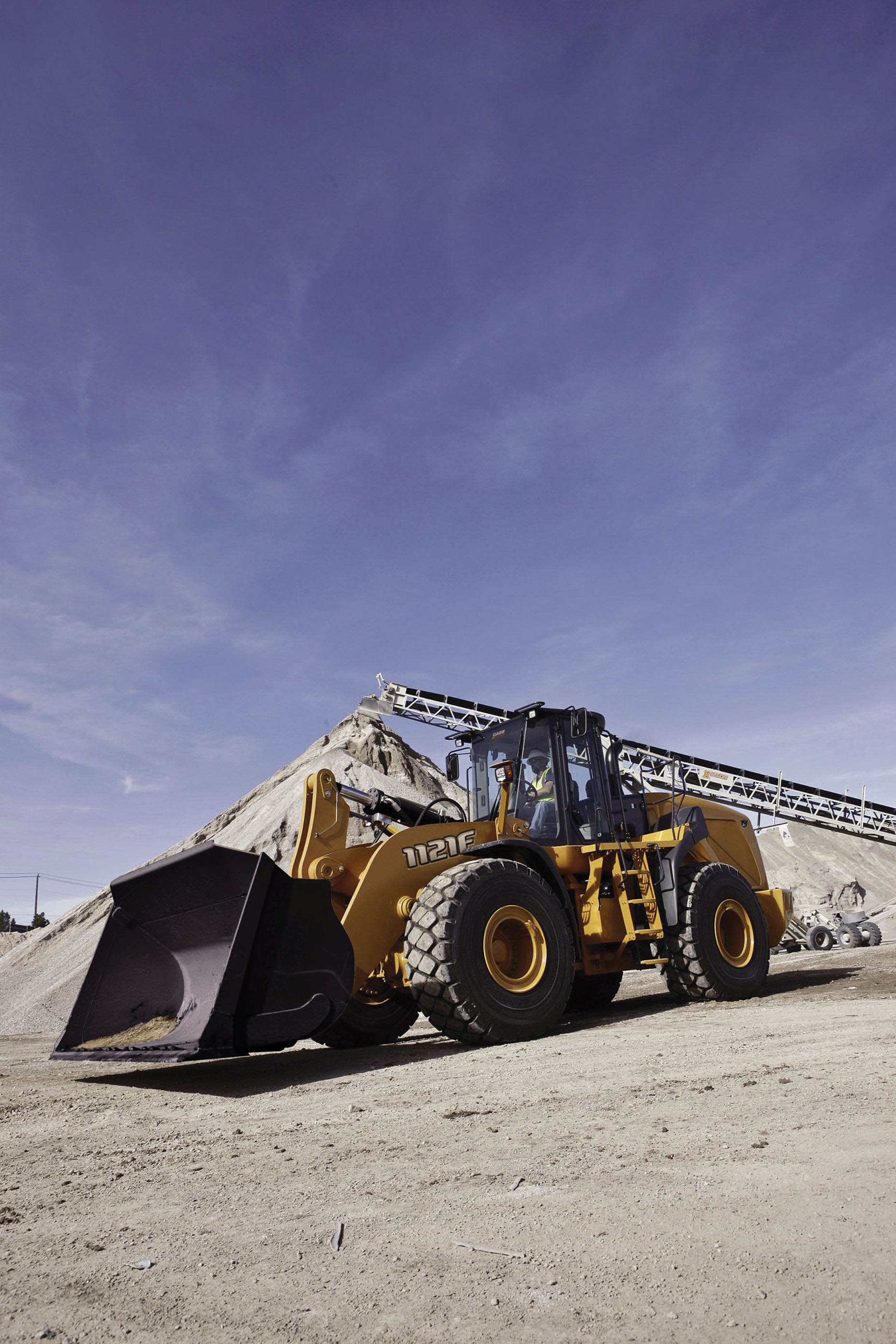
The loading of materials at a quarry has to be quick and fuel efficient. Today's equipmentis meeting these criteria as Patrick Smith reports
After excavation at a quarry, the loading of material for processing into aggregates is achieved using a variety of equipment.
Wheel loaders, excavators, dump trucks and, increasingly, special conveyors are all part of the process. With the need to keep emissions down and improve productivity and fuel efficiency, constant improvements from manufacturers such as
According to Caterpillar, accomplishing the excavation/loading phase using wheel loaders will improve conveying, crushing and screening efficiencies, and the company says that while there are no magic formulas there are dozens of places in a work cycle where efficiencies can be improved thus saving time and money.
“An efficient load area requires a good layout, a good shot and a trained wheel loader operator who has the time and experience to manage his area.
“The proper driving pattern can drastically improve efficiency. It’s not uncommon for two minutes to elapse between the time one truck is loaded and when the next gets into position. Imagine how this time impacts an operation.
“A two-minute exchange time can cost 10% of productivity. It is possible to get a truck exchange time down to one minute or less. In a large operation, that could mean an increase of a million tonnes a year per truck.”
The right truck-loader match is also crucial to the efficiency of an operation, and to make a successful match operators then need to examine loader capacity and bucket size, says Caterpillar, whose new 966K CVT wheel loader, equipped with a Cat Constant Velocity Transmission, will take centre stage at its
Caterpillar says: “The CVT does not require a torque converter and there are no gears to shift. The result is significant efficiency gains compared to conventional drive trains, achieved at lower initial costs than hybrid and electric drive machines.”
At Volvo Construction Equipment, Per Leis, the company’s director of market support for wheeled loaders at Volvo Construction Equipment Region Europe, says that as well as high productivity and enhanced fuel efficiency, up-time is perhaps the crucial component that forms the backbone of any construction business.
“It is all about productivity and therefore up-time is massively important. Throughout Europe we have an established and superb dealer network, which offers excellent service,” says Leis.
One of the company’s latest wheel loaders, the Stage IIIB-compliant L250G, now has 12 months’ on-site experience having been tested by, among others, German company Löderburger Baustoff + Transport (LBT), part of the larger Ferdinand Wesling Group.
LBT operates a quarry in Stassfurt, Germany, where ten loaders are used to help produce 2million tonnes of limestone each.
The Wesling Group, a major Volvo CE customer, runs a fleet of over 35 wheel loaders across Germany and buys two or three new machines each year. Because of its history with Volvo CE, LBT was chosen to test out the new Volvo L250G wheel loader.
The machine is said to have earned itself a reputation over the past months, proving to be highly suited to both tunnelling and block handling applications.
“That said, the L250G is also exceptionally strong when it comes to face work in quarrying, where the Z-bar configuration offers superb breakout force,” says Leis.
“The L250G has now proved itself in the market to be perfect for loading 30-40tonne articulated haulers and even small rigid haulers.
“Operators have access to a broad torque range at low rpm. As a result, high productivity can be attained while operating the machine at below 1,400rpm, which offers optimum fuel efficiency.
“We are already seeing that our new G-Series wheeled loaders are working long hours with high productivity and fuel efficiency as prerequisites. We anticipated that this would be the case and therefore also enhanced the operator environment across the Series to help operators fulfil their production targets.”
In the Midlands region of the UK, JPE, a leading supplier of primary, secondary and recycled aggregates, clays and soils, has taken delivery of five new Doosan Infracore Construction Equipment wheel loaders and excavators, and the new DL450 and DL420 wheel loaders and DX225LC and DX380LC crawler excavators, which are being used in the company’s recycling and waste handling operations across the Midlands.
A new DL420 wheel loader is being used for loading work at the JPE operation at Tamworth, Country Warwickshire, where the company runs a washing plant producing a range of fully washed recycled aggregates including sand and 40, 20 and 10mm gravels.
“With a bucket capacity of 4m3, the DL420 is the perfect machine for this job and offers an excellent combination of high productivity, ease of handling, power, serviceability and durability,” says JPE’s managing director Steve Birch.
Doosan is also launching the DL450-3 model, the first in its new generation large wheel loaders. Powered by a
With a bucket capacity of 4.5m3, the new wheel loader is intended to meet a wide range of material handling needs from loading and transporting granular material (such as sand and gravel) to industrial, mining and quarrying.
Meanwhile, Hyundai’s existing -9 Series excavators and wheel loaders, which the company says are firmly established in all major markets, are being updated with the new -9A Series excavators and wheel loaders.
“The most significant change in the update programme is the introduction of EU Stage IIIb-compliant diesel engines, with reduced exhaust emissions and improved fuel economy, and other operating and control system refinements,” says Hyundai.
As Hitachi Construction Machinery (Europe) (HCME) prepares to launch its range of Zaxis-5 medium and large excavators including the ZX250LC-5, ZX290LC-5, ZX350LC-5 and ZX470LCH-5 with operating weights ranging from 25,300–27,300kg up to 48,500–50,400kg, other models from the company are operating in quarries worldwide including at one in France.
The range of Zaxis-5 models has been developed by the Design Centre at Hitachi Construction Machinery (HCM) in Japan, where Yusuke Kajita, general manager of HCM’s Construction Equipment Development Centre, says: “We develop new machines, concepts and specifications in accordance with customer and market requirements. For example, the European market demands comfort, efficiency and controllability. I believe that the Zaxis-5 is even more suitable to European requirements than the Zaxis-3. The Zaxis-5 has better fuel efficiency, lower noise levels, excellent comfort and even iPod connectivity.”
In Brittany, France, leading quarrying company Pigeon Carrières (part of the Groupe Pigeon) ordered two new large Hitachi ZX870LCR-3 excavators for one of its large granite quarries near Rennes. The other is at a limestone quarry.
The 50-hectare granite quarry, where the first ZX870LCR-3 works, joins a ZX670LCR-3 in loading blasted rock on to rigid dump trucks. A Hitachi ZW310 wheel loader has also been supplied by local dealer, Cobemat, for loading 3,000tonnes of aggregates on to 150 delivery trucks per day.
Cobemat's managing director Xavier Beaulieu says: “Brittany covers a vast and diverse area that includes many quarries, an industry sector for which Hitachi is renowned. We enjoy a close working relationship with our quarrying customers and have developed a sizeable market share with large Zaxis crawler excavators.”
Among international launches from Komatsu Europe International are will be the PC240LC-10 and PC700LC-8 excavators and the recently-launched 28.1tonne payload HM300-3 articulated dump truck (ADT), which is powered by a Komatsu SAA6D125E-6 engine that is EU Stage IIIB and EPA Tier 4 Interim emission certified.
With the introduction of the PC240LC-10 hydraulic excavator to the European market Komatsu launched its new dash 10 range, featuring “improved efficiency, lower fuel consumption, better operator comfort, and enhanced serviceability to maximise productivity and lower operating costs.”
Weighing in at up to 26,100kg, the PC240LC-10 is powered by a 132kW Komatsu SAA6D107E-2 engine and is also EU Stage IIIB / EPA Tier 4 Interim emission certified while the PC700LC-8 has a gross horsepower of 323kW; an operating weight between 65,540-67,100kg and bucket capacities up to 5.58m³ can be installed.
Case Construction Equipment says it is offering productivity, fuel economy and reliability to the quarry and aggregate industries, with the introduction of the 1021F and 1121F wheel loaders.
“These two machines take Case into a new class, bringing SCR and advanced cooling technology, plus a higher bucket payload, to this sector of the wheel loader market,” says the company.
“The two machines benefit from a clean-sheet design. Both loaders are powered by a Tier 4 Interim certified engine. The 1021F offers an operating load of more than 8tonnes, while the larger 1121F has an operating load of around 9tonnes, enough to fill a 27tonne dump truck in three passes.
Conveyors get moving
Modern mining technologies require belt conveying systems that are capable of moving increasingly larger volumes.
“Companies require effective options for transporting bulk goods such as ore, coal, gravel or sand for example from the mine, sand pit or quarry to the plant,” says the
The group contends that often “transportation by truck is expensive and has a negative impact on the environment,” with a continuous conveyor, such as troughed or tubular belt conveyors being “an economical alternative.”
BEUMER claims that with the right design the conveyors can be optimally adapted to the environmental conditions, minimising or eliminating pollutants such as dust, noise emission and exhaust gases.
“Even in difficult environments, the construction work for these systems is minimal,” says the company, whose belt conveyors are used as closed tubular belt conveyors or as open troughed belt conveyors. “Tubular belt conveyors are suited, for example, for powdery material and on steep routes, while the open troughed belt conveyors are used for robust or coarse material.
“Due to their routing, the belt conveying systems negotiate rugged terrain and other obstacles, such as rivers, streets, buildings or train tracks. This reduces the costs of moving earth and expensive transfer points are significantly reduced. Horizontal and vertical curves can even overlap.”
BEUMER says it has implemented belt conveying systems with centre distances of more than 10km, and with the focus now often on energy efficiency, motors in the systems can be controlled, making optimal load distribution in the belt possible in all operating conditions.
Indeed, depending on the terrain and loading condition, the systems can also operate as generators, with such generated electric energy fed to the mains by a regenerative feedback unit, helping to reduce energy costs for operating the whole system.
Telestack: radial conveyor
Meanwhile,
Powered by an on-board genset or from the site’s own electricity supply, the TS 532 can easily be moved around the site or from site to site (for global shipping it can also be packed into 2 x 40ft containers).
“It offers the crushing/screening contractor or quarry owner/operator a safer site, improved environmental performance and lower operating costs,” says Telestack, which recently launched its new website (%$Linker:
“Traditionally, quarry owner/operators use fixed length/fixed height conveyors or wheel loaders/dozers to build stockpiles. While the traditional methods have their benefits, they also have disadvantages.”
Telestack says its TS 532 ensures that the final material in the stockpile remains within specification, and it lists multi-nationals such as
“Radial telescopic technology is well proven and has been used for over 25 years to build stockpiles. The main benefits of this technology are eliminating segregation and degradation by stockpiling in a series of windrows. Telestack creates these windrows using its radial, telescopic and luffing functions.”
The aggregate has an average fall height of 1.5m and is locked into channels within the stockpile, confining the particle distribution to a very small area, thus maintaining the required mix throughout the entire stockpile. “Stockpiles formed using radial telescopic conveyors have been shown to produce material of a consistent particle-size distribution throughout,” says Telestack.
“Health and Safety is improved on the site as using a Telestack reduces the potential for human error. Also, the TS 532 can be retracted and lowered to the ground for safer access for maintenance.”
Telestack says that because discharge height of the conveyor is no more than 1.5m from the stockpile dust is reduced, while other claimed environmental benefits for the TS 532 include reduced noise emissions, carbon footprint and low fuel/power consumption.
“Given the flexibility of the road mobile feature, the TS 532 has excellent re-sale values as it can be sold on a global basis for use in stockpiling, ship-loading, barge-loading, variable length link conveyor, back-filling and product placement applications, says Telestack.
“The TS 532 can quickly and easily be set up to operate after a mobile or static crushing and screening plant for crushing and screening contractors or for owner/operators with more than one quarry location.”
Loader/unloader
A single chassis mobile loader/unloader for transport and onsite mobility was seen as the answer to a loading problem at a small port terminal in Belgium.
A common issue in the bulk handling sector is the need to transfer materials from the site of processing to the end user, and in Belgium the loader/unloader tracked unit with a large receiving hopper to receive feed from trucks and wheeled loaders at a transfer rate of up to 1,000tonnes/hour.
“Radial slew capabilities ensure the unit is versatile in limited ground space applications and secondary use as a stockpiling solution where terminal space is at a premium. The mobile unit is folded ready for road transport in less than ten minutes,” says Trackstack, part of the
“The latest Trackstack development was ideal for this application. The unit is able to load up the barges without the need to reposition either the VL1000 or the barge unit,” says Trackstack.
“The VL1000 can receive material direct from tipping truck or wheeled loader and transfer it directly onto a radial conveyor.”
The VL1000, easily moved between sites, has a stockpiling capacity of over 7.5m which means storage floor space can be reduced for operators.


